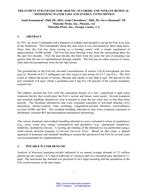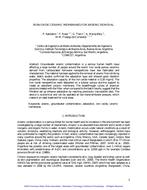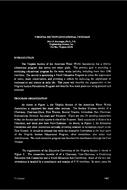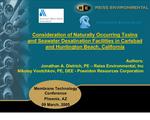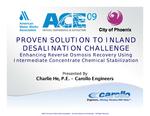Provide PDF Format
AWWA WQTC62548
- Treatment Strategies for Arsenic, Fluoride and Nitrate Removal - Minimizing Water Loss and Energy Consumption
- Conference Proceeding by American Water Works Association, 11/01/2005
- Publisher: AWWA
$12.00$24.00
In 1951, an Army Commander led a battalion of soldiers and decided to set-up his Fort in an areain the Southwest. The Commander chose this area since it was surrounded by three large lakes.Since then the Fort has been serving as a training center with a steady population ofapproximately 16,000 people. The Fort has been drawing water from the surrounding lakes forthe past five decades. Over the past decade, the lakes went dry since the rate of pumping wasgreater than the rate of replenishment through rainfall. The Fort has no other sources of water,other than the groundwater from the dry lake basins.The groundwater at the Fort has elevated concentrations of arsenic (24-36 micrograms per liter(µg/L)), fluoride (6.4-7.5 milligrams per liter (mg/L)) and nitrate (4.3-5.7 mg-N/L). The Fortwants to reduce the levels of arsenic, fluoride and nitrate to less than 8 µg/L (80 percent of thenew standard), 0.8 mg/L (State's guideline) and 5 mg-N/L (50 percent of the current standard),respectively.The authors assisted the Fort with the conceptual design of a new, centralized 6 mgd watertreatment facility that would meet the Fort's current and future water needs. Several treatmentand residuals handling alternatives were evaluated to keep the net water loss to less than threepercent. The treatment alternatives that were evaluated consisted of activated alumina (AA)adsorption, anionic/cationic resin exchange, coagulation-assisted filtration, electrodialysisreversal (EDR) and reverse osmosis (RO). The residuals handling alternatives that were evaluated consisted ofdistillation, seawater RO and precipitation/mechanical dewatering.The various treatment and residuals handling alternatives were evaluated in terms of quantitative(e.g., costs, water loss, energy consumption) and qualitative (e.g., operational complexity,reliability, modularity) drivers. A scoring and ranking of the alternatives was performed using amulti-criteria decision program (Criterium Decision Plus). Based on this study, a phasedapproach of treatment and residuals handling to sustain the operation of the Fort for several yearswas recommended for implementation. Includes tables, figures.
Related Products
AWWA MTC61187
Consideration of Naturally Occurring Toxins and Seawater Desalination Facilities in Carlsbad and Hun..
$12.00 $24.00
AWWA ACE70886
Proven Solution to Inland Desalination Challenge: Enhancing Reverse Osmosis Recovery Using Intermedi..
$12.00 $24.00

